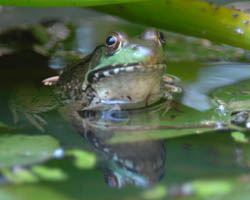Vol. 5 Issue 3, Summer 2000
By Patty Selly
If you are lucky enough to have a pond, stream, or vernal pool on your property, you already know the appeal that water has for wildlife. A reliable source of water will attract a variety of birds, amphibians, mammals, and even reptiles.
From a strategically-placed shallow pan of water to the most elaborate water garden, nothing lures wildlife like water, and during a long, hot, dry summer, animals often have quite a challenge in finding fresh water to drink and bathe in. You have plenty of choices when incorporating water into your landscaping or gardening plans. Often, a bird bath is the easiest way to get started.
 For starters, a shallow pan of water is great. Look for things you already have on hand: a large dish or platter, the water dish from a planter, or even a metal garbage can lid placed on the ground and filled with water will do the job. Just choose a level spot with some cover nearby.
For starters, a shallow pan of water is great. Look for things you already have on hand: a large dish or platter, the water dish from a planter, or even a metal garbage can lid placed on the ground and filled with water will do the job. Just choose a level spot with some cover nearby.
There are dozens of styles of bird baths available for purchase. They range from elaborate carved stone and cast iron to resin that is both light and maintenance-free. Remember, the water is here to simulate a natural puddle so it should be shallow. You don’t want the water to be any deeper than about three to four inches, The slant should be gradual and there should be traction on the bottom of the pool (such as sand or gravel) to provide “footing” for the birds.
When placing a bird bath in your yard, try to position it near a high perch such as a tree, fence post, or even a telephone wire. The birds will use the perch to look out for predators before venturing into the water, and will return to it for preening afterwards. Some birds, like thrushes and towhees, will prefer to visit secluded garden pools hidden among dense vegetation.
You might also provide a fine mist or spray which the birds can bathe in. Moving water seems to be irresistible to some birds. Attach a garden hose to a tree branch, turn it to a fine mist, and watch the fun! You can even buy “specialized” spray misters at bird feeding stores. Another simple way to provide moving water is to fill a bucket or gallon jug and hang it from a tree over a bird bath. Punch a very small hole in the bottom. The water will drip out, little by little, and the birds will fly through and stand under the moving water to bath.
You may wish to go a step further in incorporating water in your garden, and install your own pond. Early this spring, I decided to create a small shallow pond which would attract amphibians and provide the birds with a protected, secluded watering area. Judging from the tracks I have seen near the water’s edge, I know that an opossum and several deer have also visited the area recently.
A pond is not difficult to add to your garden. You can go the simple route and buy a pre-formed plastic pond liner (even a kiddies pool will work!); dig a hole, plop in the liner, and fill it with water. A second alternative is to dig out the pond in the desired shape and depth, and then purchase plastic liner to fit the pond. Pond liner, sold at garden centers, is thick and works well, but landscaping plastic works just as well at about a third the cost.
When installing your pond, make sure that the sides have gently sloping edges. Many frogs, toads, and even turtles are drowned in garden ponds because the sides are just too steep for them to climb out. if it is impossible to control the slope of the sides, place lots of rocks, floating vegetation, and pieces of wood in your pond that the animals can use to climb out. Choose your location carefully, and plan it out so there is cover near the water’s edge, and some shady spots in your pond.
Adding water to your garden in fun, rewarding and easy to do. Why not try It this summer? Our local wildlife will benefit from it, and so will you!
To find native plants and the species that benefit from them, check out our Gardening for Wildlife Plant List.

